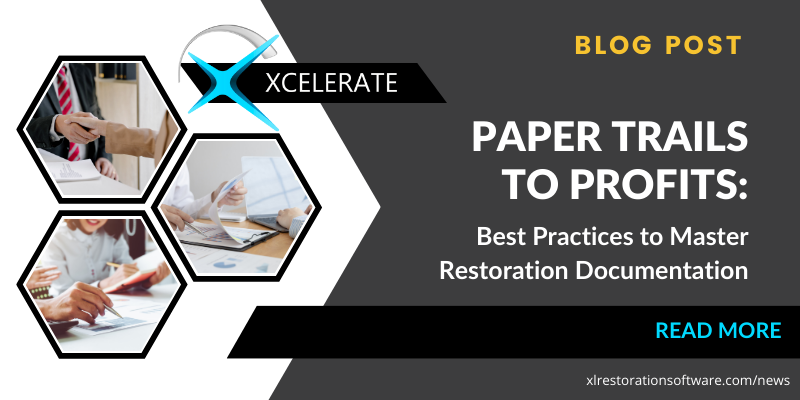Paper Trails to Profits: Best Practices to Master Restoration Documentation
January 30, 2024 •Ember Davis

Documentation stands as the backbone of success in the Restoration Industry. Beyond paperwork, it's a strategic tool that ensures efficiency, compliance, and client satisfaction. Join us as we unravel the significance of documentation and explore best practices to elevate your restoration game.
Why Documentation Matters in Restoration
Legal Compliance and Accountability:
Documentation is your shield in the legal realm. Properly documented processes and actions safeguard your business, ensuring compliance with regulations and providing a transparent trail of accountability. In the event of disputes or regulatory scrutiny, having a well-documented record can be the key to demonstrating adherence to industry standards and ultimately ensuring you get paid.
Client Confidence and Satisfaction:
Transparent documentation instills confidence in your clients. It becomes a tangible proof of your commitment, providing clients with a detailed record of the restoration journey and fostering trust in your services. Clients are reassured when they can access detailed information about the restoration process, ensuring they are well-informed and confident in the work being carried out.
Efficiency in Project Management:
Well-documented processes streamline project management. From tracking project timelines to managing resources effectively, documentation serves as a roadmap for seamless operations. By maintaining organized and accessible project documentation, you enhance communication among team members, reduce errors, and increase overall project efficiency.
Best Practices for Effective Documentation
Comprehensive Project Logs:
Maintain detailed project logs. Include project timelines, milestones achieved, and challenges faced. This comprehensive record becomes invaluable for project analysis, client communication, and future planning. Project logs serve as a historical account of the restoration process, aiding in identifying patterns, improving future projects, and facilitating better decision-making.
Photographic Evidence:
A picture is worth a thousand words. Supplement your documentation with photographic evidence. Capture project stages, damages, and restoration progress. Visual documentation enhances clarity and serves as a powerful communication tool. Photographs not only provide a visual record but also offer valuable insights into the condition of structures and the effectiveness of restoration efforts.
Thorough Job Reports:
Crafting thorough job reports is a foundational aspect of effective documentation in the restoration industry. These reports go beyond mere paperwork; they encapsulate the essence of the restoration process, providing a detailed account of the scope of work undertaken, materials utilized, and any unexpected challenges encountered during the project. By meticulously detailing these elements, a well-constructed job report becomes a cornerstone for project assessment, offering valuable insights into the intricacies and successes of the restoration endeavor.
Communication Trail:
Document all communication. Whether it's with clients, contractors, or team members, maintaining a communication trail is crucial. It ensures that everyone involved is on the same page, minimizing misunderstandings and disputes. A documented communication trail acts as a record of decisions, instructions, and agreements, reducing the risk of miscommunication and providing clarity in case of disputes.
Regulatory Compliance Records:
Stay ahead of regulatory requirements. Document adherence to safety protocols, environmental regulations, and industry standards. This not only protects your business but also showcases your commitment to responsible restoration practices. Regulatory compliance records demonstrate your commitment to maintaining high standards in safety, environmental responsibility, and overall industry compliance.
Training and Certification Records:
Keep meticulous records of employee training and certifications. A well-documented training history ensures that your team is equipped with the necessary skills, fostering a culture of expertise and professionalism. Training and certification records provide a structured approach to employee development, ensuring that your team remains well-trained and up-to-date on industry best practices.
The Role of Technology in Documentation
Digital Documentation Platforms:
Embrace restoration job management tools. They offer centralized storage, ease of access, and enhanced collaboration. Digital documentation not only reduces paperwork but also provides a secure and efficient way to manage vast amounts of information. Software platforms for restoration project management ensure that documentation is easily accessible, searchable, and can be updated in real-time, enhancing overall efficiency and collaboration.
Mobile Documentation Tools:
Equip your team with a job management platform that is available on the go. Empowering field personnel to document processes, capture images, and update records in real-time enhances the accuracy and timeliness of documentation. Mobile restoration software enable on-the-spot documentation, reducing the chances of information gaps and ensuring that data is captured as events unfold, contributing to more accurate and real-time documentation.
Conclusion: Elevate Your Restoration Game with Effective Documentation
In the dynamic world of restoration, documentation isn't just a formality—it's a strategic imperative. Elevate your restoration game by adopting best practices in documentation. From legal protection to client satisfaction, the impact of effective documentation reverberates throughout your entire operation.
Discover how Xcelerate Restoration Software can seamlessly manage your documentation needs. Contact us to explore a platform that amplifies your ability to document, manage, and succeed in the restoration industry.

